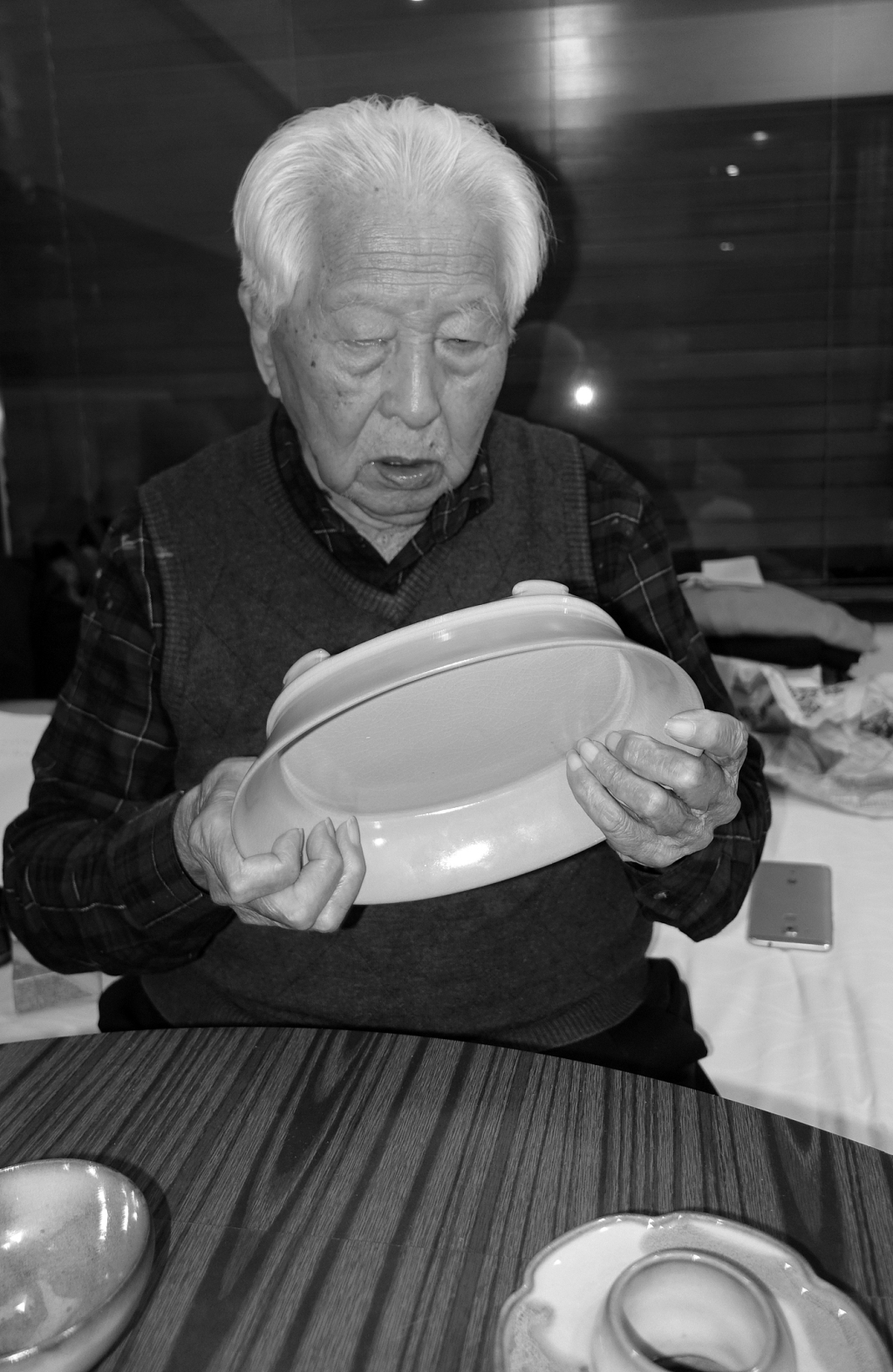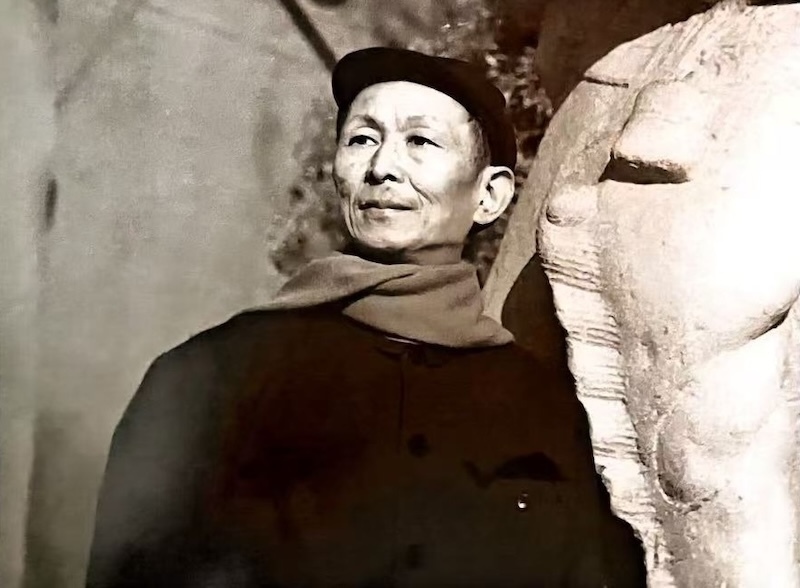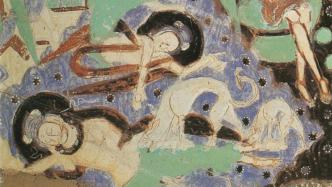
The largest Gandhara art exhibition in China so far, "For example Xiangshan", is being exhibited in the Wenhua Hall of the Palace Museum (until June 15), displaying 203 pieces from Pakistan and the Palace Museum collection.
The Buddha Jataka story tells the story of the Buddha's practice in the reincarnation of the previous life, which is a part of the life history of the Buddha. One of the most famous Jataka stories is the Jataka story of sacrificing oneself to feed a tiger. It originated in Gandhara and became a very popular theme in Chinese Buddhist art after it was introduced to China. Images of sacrifice to feed tigers frequently appear in Kizil Grottoes, Dunhuang Mogao Grottoes, Maijishan, Yungang, Longmen and other grottoes. This article attempts to further analyze the relevant images and texts, and dig out more details about the Jataka in Gandhara Buddhism.
The core concept of the Buddhist view of life is the cycle of life and death. The Jātaka story tells the story of the Buddha's practice in the reincarnation of the previous life, and is part of the life history of the Buddha. One of the most famous Jataka stories, Vyāghri—Jātaka, originated in Gandhara and became a very popular theme in Chinese Buddhist art after it was introduced to China. In the Kizil Grottoes, Dunhuang Mogao Grottoes, Maijishan, Yungang, Longmen and other grottoes, as well as the gold and copper Ashoka Pagoda in the Five Dynasties and early Song Dynasty, there are a large number of images of feeding tigers. Jataka, who sacrificed his life to feed a tiger, also often appears in Chinese translations. Starting from the "Xiuyueben Qijing" translated by Kang Mengxiang in the second year of Jian'an in the Eastern Han Dynasty (197), there are more than ten Buddhist scriptures that record this story. Most of the extant material related to the Jataka sacrifice to feed the tiger is preserved in Chinese Buddhist art and Chinese translations. Therefore, the research on this Jataka story mainly focuses on the research on the images and texts of Chinese sacrifice to feed tigers, and has achieved fruitful results.
Feeding the Tiger Jataka also plays an important role in Gandhara Buddhism. The place of feeding the tiger is one of the Buddhist holy places that attracted Chinese monks to pray for Dharma in the Middle Ages. Faxian (approximately 334-420), Xuanzang (602-664) and other eminent monks who traveled westward to seek the Dharma repeatedly recorded their deeds of visiting the place where they sacrificed themselves to feed tigers. According to Faxian's records, the memorial tower where he sacrificed himself to feed the tiger is one of the four major towers in Northwest India, with gorgeous decoration and many believers. Regrettably, for a long time, there have been few specialized studies on Jataka, who sacrificed his life to feed tigers in Gandhara. As a result, people only know the importance of the story in Gandhara, but not its specific circumstances. Therefore, this article attempts to further analyze the relevant images and texts, and dig out more details about the Jataka in Gandhara Buddhism.
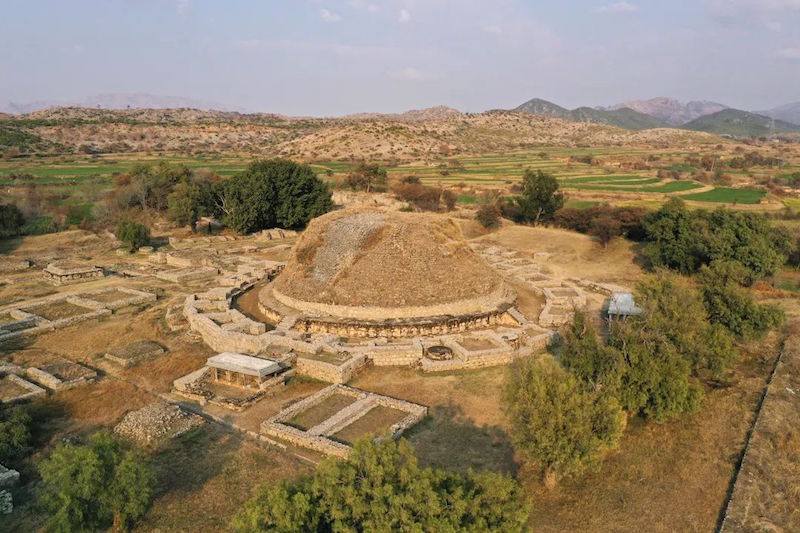
The main archaeological sites of ancient Gandhara are distributed in the area from the Peshawar Valley in northern Pakistan to the east bank of the Indus River and the east of the Kabul Valley in Afghanistan. The picture shows Dharmarajika, the ruins of the ancient city of Dharmarajika.
1. The image of feeding tigers in Gandhara
There are very few remains of images of sacrificing one's life to feed a tiger in Gandhara, and only two cases can be identified so far. One of them was carved on one side of a small square stone tower, dating from the 2nd to 3rd centuries AD. The image is simple: a person in the middle is lying on his back, his right arm is naturally straightened, a big tiger is lying on his chest and biting; there are several small tigers around the person's head, the number is not less than four. (Picture 1) The images of the other three sides of the tower have not been released, and the specific content is unknown. The Peshawar Museum also has a stupa with almost the same shape in its collection. Judging from the style, both belong to the works of the central region of Gandhara. This image of sacrificing one's life to feed a tiger is the only surviving real relic of one sacrificing one's life to feed a tiger in the central area of Gandhara during the Guishuang period. It intuitively shows the appearance of Gandhara's sacrifice to feed a tiger. At the same time, this is also the earliest known image of feeding a tiger, which provides direct evidence for the argument that the tiger was originally born in Gandhara.
Until the late Northern Wei Dynasty, images of feeding tigers by sacrificing their lives were still popular in the central area of Gandhara. "Luoyang Jialan Ji" records the deeds of the first year of Zhengguang (520) when Huisheng saw the Queli Buddha in Gandhara, and asked craftsmen to cast the "Queli Buddha Ritual" and "Shakya Four Pagodas" in the local area:
Then travel southwest for sixty li to Qianduoluo City. Seven li to the southeast is the Queli Pagoda... Song Yun served the Que Li Pagoda with two servants and maidservants, and they would always fill the pagoda. Huisheng then cut down the capital, and a good craftsman, who was ingenious and simple, used copper to reproduce the body of Queli Buddha and the four towers of Shakyamuni.
"Queli Futuyi" is a small stupa model, and "Shakya Four Pagodas" refers to the disguised pictures of the Jataka stories at the four major pagodas in Northwest India, including the picture of sacrificing oneself to feed a tiger. The word "copy" indicates that the two have their own sources, and they are based on the popular local shapes and image styles. Moreover, the "Change of the Four Pagodas of Sakyamuni" is very likely to be an auxiliary image decorated on the "Queli Pagoda Ritual", and the practice of adorning the image of sacrificing one's life to feed a tiger on a small stupa model may have existed for a long time in Gandhara.
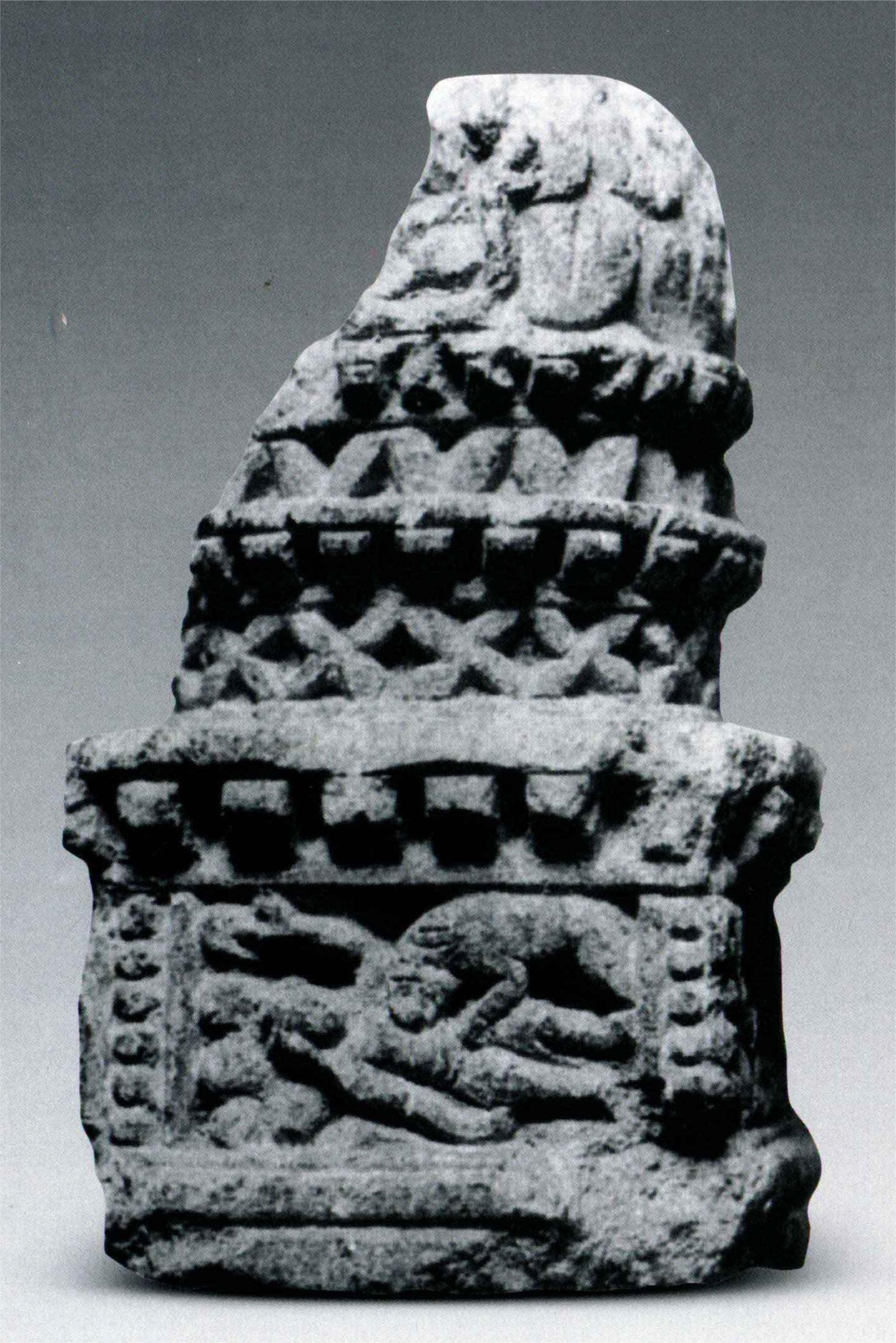
Figure 1 Relief sculpture of feeding a tiger on the remnant tower of Gandhara
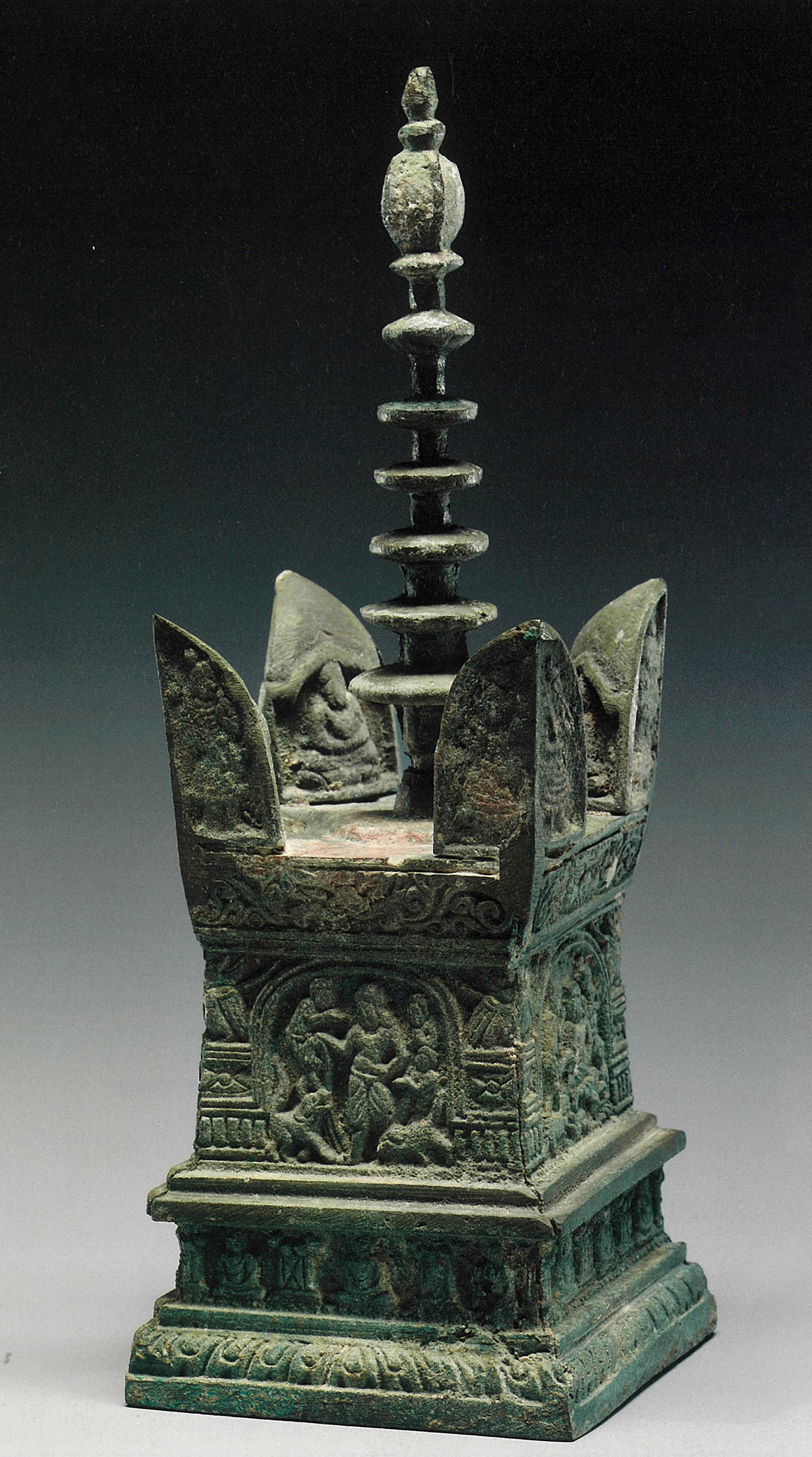
Figure 2 The Ashoka Pagoda unearthed from Jinhua Wanfo Pagoda
A large number of Ashoka Pagodas from the Five Dynasties to the early Song Dynasty unearthed in China, Japan, and Korea provide physical evidence for the long-term continuation of this practice. All of these small pagodas have a square body, and the four sides of the pagoda are cast with images of Buddha Jataka that are consistent with the content of the "Shakyamuni Four Pagodas". (Figure 2) According to the description of the appearance of the Ashoka Pagoda worshiped by Jianzhen (688-763) in the "Tang Dahe Shangdong Zhengzhuan" written in the 14th year of Tang Dali (779), at least in the Tang Dynasty Tianbao (742-742- 755) before the Ashoka Tower with the same schema existed. The cultural origin of many images and their combinations on the Ashoka Pagoda can be directly traced back to Gandhara Buddhist art, such as the combination of high round arched niches and Garuda, the combination of meditation Buddha statues on the base and square columns, etc. The method of casting the image of sacrificing oneself to feed a tiger on the square tower of the Ashoka Pagoda probably also originated from the Gandhara region. This practice is an intuitive reflection of the image of sacrificing one's body feeding a tiger in Chinese Buddhist art.

Figure 3: A line drawing of the rock painting of Zilas sacrificed his life to feed a tiger
Another example is the sacrificial tiger petroglyphs located in the Chilas region in the north of Swat, which belongs to the region of Greater Gandhara. Judging from the Brāhmī inscription next to the picture and the style of the image, the age of the rock painting is around the 5th century.
At the bottom right of the picture, the tiger feeder is only wearing shorts, lying flat on the ground, with a small tiger lying on his chest; the sacrificer puts his right hand in front of his chest, and his left hand is naturally straight; his earlobe is huge, and the top of his head protrudes like a bun. It is the image of a practitioner. At the bottom right of the picture (according to the direction of viewing the petroglyphs), there are no less than four tigers walking towards the victim. On the upper right of the picture, three people stand behind the cliff, bare upper body, wearing shorts similar to those of the sacrificial victim, without any decorations; The left finger points to the person on the right and turns his head as if to communicate with him; the person on the right has a beard, pinches his waist with his left hand, and builds a pergola with his right, leaning forward and looking down. In the upper left of the picture, there is a person in the tree trunk, showing half body, wearing a round-neck top, with his right hand on his chest, and his left hand looking down under a pergola. (Picture 3)
Some scholars speculate that the person in the trunk is the "Bodhi Tree God", and based on this, they believe that the rock painting may be drawn according to the "Golden Light Sutra Sacrifice". However, after reading the content of the scriptures carefully, we can find that the Bodhi tree god is the hearer of the story of feeding the tiger rather than the witness, and she and Prince Sattva do not exist in the same time and space. It is unreasonable for the so-called "Bodhi tree god" to appear at the scene of feeding the tiger.
To interpret this petroglyph, we must first answer a question: Is the picture "one picture, one scene" or "one picture, multiple scenes"? If we use the "Golden Light Sutra Sacrifice of Life" to explain it according to the past. The scene of the three people on the cliff and the scene of feeding the tiger under the cliff belong to two different scenes. Because according to the content of the scriptures, the three people on the cliff were three princes playing in the mountains. What they saw was the tiger mother and child dying of hunger and poverty at the bottom of the cliff, not the scene of feeding the tiger at the bottom left of the rock painting.
Going back to the image itself, judging from the gazes of the people, the pointing of the hands and the direction of the body leaning forward, the focus of the picture is on the scene of sacrificing oneself to feed the tiger under the cliff, which is more like a scene that happened at the same time. Moreover, in the Thalpan area not far away, the Buddhist biographies and Jataka rock paintings of similar ages are all in the form of "one picture and one scene", such as "conquering the devil and becoming enlightened", "turning the wheel of Dharma for the first time", " Rock paintings such as King Sibi Jataka and Five Immortals Jataka.
On the other hand, although the above-mentioned petroglyphs are relatively concise in depiction of characters, they do not omit key features such as hairstyles, crown ornaments, clothing, and handprints that can reflect the identity of the characters. Therefore, the three naked and undecorated figures on the cliff are unlikely to be the image of a secular prince. We tend to think that the petroglyphs of feeding a tiger with one's life are presented in the mode of "one picture, one scene", and the three people on the cliff are not the three princes but the audience when the prince gave his life to feed a tiger.
This view can also be confirmed by Buddhist scriptures, which can be found in Fasheng's translation of "The Sutra of the Causes and Predestinations of Buddha Saying that Bodhisattvas Dedicate themselves to (Yi) Hungry Tigers Arise from Pagodas" (later called "Fasheng's Translation", translated in the 1930s and 1940s). , the prince threw himself on a cliff to feed a tiger under the witness of everyone. The relevant descriptions are consistent with the petroglyphs to a certain extent:
At that time, all the people at Yatou looked down and saw that the prince was eaten by a tiger, his bones and flesh were messed up, and his wailing and screaming moved the mountain;
Fasheng once visited Gandhara to pay homage to the sacred site, and his translation is closely related to the Jataka of Gandhara. The petroglyphs of Zilas may have been influenced by the Buddhist scriptures related to Fasheng’s translation. partial impact. Judging from the images of feeding tigers in the 5th and 6th centuries in China, different versions of the story of feeding tigers in this period have their own popular areas. The images of feeding tigers with sacrifices in Xinjiang are mainly based on "The Sutra of the Worthy and Foolish: Mahasattva Giving the Tigers with Your Body" (translated in 455), and most of them show a picture of a tigress and two tiger cubs eating the crown prince; (Fig. 4) Hexi to the east of Xinjiang and the northern part of the Central Plains are mainly drawn based on the "Golden Light Sutra Sacrificial Products", and the number of tigers is generally more than three. (Picture 5) The rock paintings of Sacrifice Feeding a Tiger in Qilas are located in the west of Xinjiang, and it is very unlikely that they were drawn according to the "Golden Light Sutra Sacrifice".
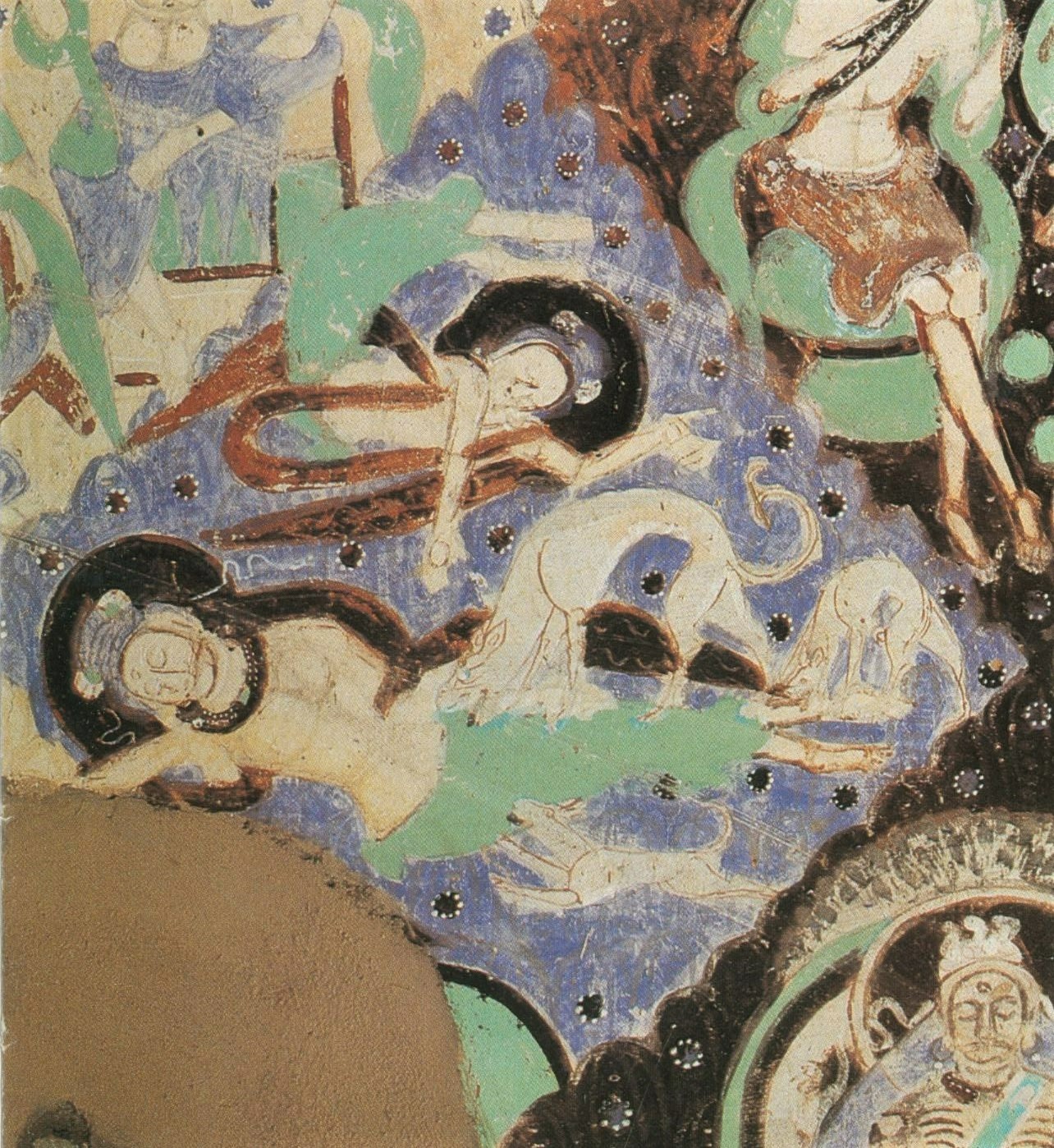
Figure 4 The mural painting of feeding a tiger with sacrifice in Cave 17 of Kizil Grottoes
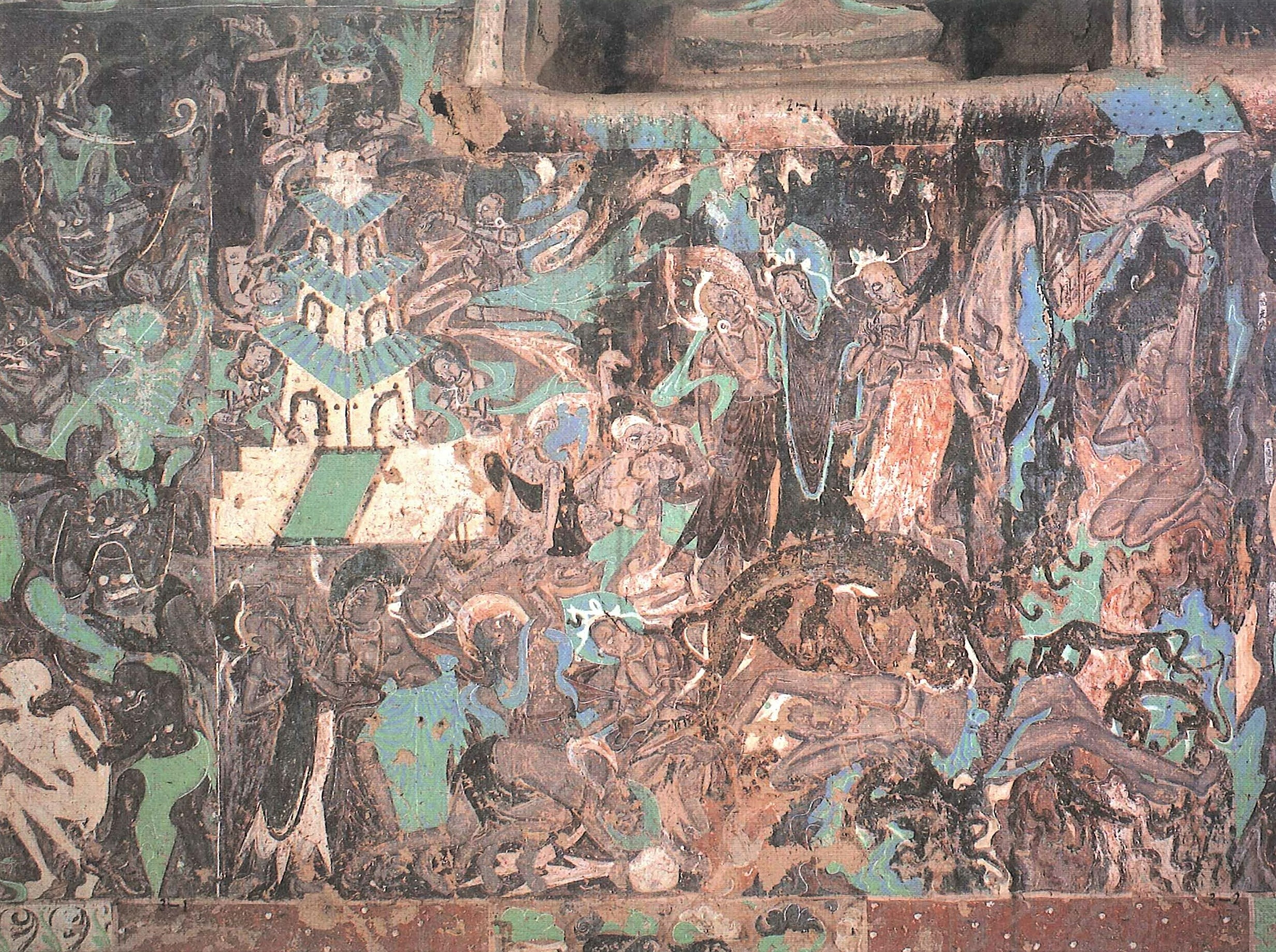
Figure 5: Mural of Cave 254, Mogao Grottoes, Feeding a Tiger
2. Fasheng Translation: The Text of Sacrificial Feeding a Tiger from Gandhara
In addition to the images of Gandhara's sacrifice to feed a tiger, the Fasheng translation is also closely related to Gandhara's sacrifice to feed a tiger Jataka. The beginning of the scriptures clearly explained the place where the story took place: "At one time, the Buddha traveled to the great city of Vishamonpolo in the Qiantuoyue Kingdom, and under the shade of the rocks in the north of the city, he taught the king, his subjects, the eight tribes of heaven and dragon, human and non-human, etc. , saving countless people.”
In the "Kaiyuan Shijiaolu" written by Zhisheng in the eighteenth year of Kaiyuan (730) of Tang Dynasty, he recorded the postscript of the translation of this sutra, recording what Fasheng saw at the place where he sacrificed himself to feed the tiger:
The postscript of the Sutra of Devotion to the Hungry Tiger says: "At that time, the king had heard the Buddha's words, so he erected a big tower there, called the Bodhisattva Dedicated to the Hungry Tiger Pagoda, and it is here today. To the east of the pagoda, there is a monk's room, a lecture hall, and a fine house at the foot of the mountain, and there are often five thousand people. Monk, four things to make offerings to. When Fashenger saw that in various countries, there were people with leprosy, madness, deafness, blindness, limbs and lameness, and various diseases. They all came to this stupa, burned incense and lamps, spread incense mud on the ground, repaired it, swept it, and put it on the ground. Kowtow to the top and repent, and all diseases will be cured. Those who come to send will go, and later, there are often more than a hundred people. No matter whether you are high or low, you will never end."
Compare the record in the postscript of the translation, "At that time, the king had heard the Buddha's words, so he erected a big tower there, called the Bodhisattva and threw himself into the Hungry Tiger Pagoda, and now he sees it." The "Bodhisattva throwing himself into the hungry tiger pagoda" seen by Fasheng was built near the "Great City of Bishamenpolo in Qiantuoyue Kingdom". Therefore, Junko Matsumura believes that the Fasheng translation records the local story of sacrificing oneself to feed a tiger in Gandhara. Meng Yu believes that the "Giantuoyue Kingdom Bishamonboluo Great City" is a fictitious place, and Junko Matsumura's conclusion needs more evidence.
"Qiantuoyue Kingdom Bishamenpolo Great City" (named "Qiantamati Country" in the past nine kalpas) is one of only two place names mentioned in Fasheng's translation, the other place name is "Petisha Country" ". The word "Pei Tishe" also appeared in the travel notes written by Fasheng himself. At the end of the second volume of "Biography of the Great Monk", Fasheng's deeds are recorded: "At that time, there was a recluse Fasheng in Gaochang, and he also went to foreign countries. There are four volumes in the biography." The original book of "Liguo Zhuan" has been lost. Some of the famous objects in the book are quoted in "Translation of Sanskrit" written by the Japanese monk Nobuyuki. According to the citation of "Liguo Zhuan" in "Translation of Sanskrit", the name of the city mentions "Petisha City", which is the place where Fasheng actually visited. Therefore, Fasheng is no stranger to the name "Pei Tishe". "Petisha City" or the capital city of "Petisha Kingdom" are both written by Fasheng, and the agreement between their names should not be accidental. This shows that the place names in Fasheng's translation have a real correspondence with the places he actually visited, and the "Great City of Bishamanpolo in Qiantuoyue Kingdom" should not be fictional.
Fasheng once paid homage to the "Bodhisattva throwing himself into the hungry tiger pagoda" at the place where he sacrificed his life to feed the tiger, and witnessed the local Buddhist grand occasion and the scene of people making offerings and worshiping the pagoda. understanding. Fasheng's translation of this sutra has a reliable basis in reality, and it is not just a simple text translation.
Not long before Fasheng translated this sutra, Tan Wuchen, an eminent monk in Liangzhou, had already translated "Golden Light Sutra Sacrifice". The manuscript of the "Golden Light Sutra" written in 430 A.D. was unearthed in Turpan, which shows that this sutra was quickly spread to the Gaochang area after it was translated. Fasheng lived in the Gaochang area for a long time. According to the "Famous Monk Biography" (transcription of Japanese monk Zongxing in 1235), Fasheng met Zhimeng in Gaochang when he was nineteen years old. Zhimeng was in the first year of Yuanjia (424) Began to return from Tianzhu. Based on this calculation, Fasheng was about 27 years old when Tan Wuzhen was killed (433). It can be said that Fasheng lived in a Buddhist environment led by Tan Wuzhen in his youth; and it is impossible for him not to know the content of "Golden Light Sutra Sacrifice" before translating this sutra. The reason why Fasheng dared to challenge the authority and deliberately translated a separate version of the Buddhist scriptures that is very different from Tan Wuzhen's translation should be related to the fact that he learned the local popular version of the story in Gandhara where he sacrificed his life to feed the tiger. This is the same as the reason why Huijue, Weide and others translated "The Sutra of the Worthy and Foolish: Mahasattva Giving Yourself to a Tiger" after hearing different versions of the story at the Wushe Conference in Khotan.
Furthermore, in the afterword of the translation, a lot of pen and ink are used to describe the scene where Fasheng saw the patient Lita treating his illness at the place where he sacrificed his life to feed the tiger. Regarding this point, Xuanzang, who arrived at the place where he sacrificed himself to feed the tiger more than 200 years later, also recorded:
To the north of the sacrificial body is a stone stupa, more than two hundred feet high, which was built by King Wuyou, with strange carvings and divine light from time to time. Hundreds of small stupas and various stone niches moved around the tomb area. It has a disease, and the more it revolves, the better.
This shows that the custom of circling the pagoda to treat diseases has existed for a long time in the local area. Not only that, but there is also a record in the scriptures of Fasheng's translation that making offerings to the Prince's Sacrificial Pagoda can cure diseases. Before the prince died, he made an oath:
Now I save that hungry tiger with my flesh and blood, and I relict my bones. My parents will build a tower for them in the future. Let all sentient beings who are suffering from illnesses, past sins and predestined relationships, who cannot be dispatched by decoction, medicine and acupuncture, come to my pagoda to offer sincere offerings. Depending on the severity of the disease, within a hundred days, they will be cured.
The local people's practical activities at the place where the tiger was sacrificed to feed the tiger are very consistent with the content of the Fasheng translation, which shows that the Fasheng translation does have a strong realistic concern, and it can further prove that the Fasheng translation reflects the 4th-5th century. The real situation in Gandhara.
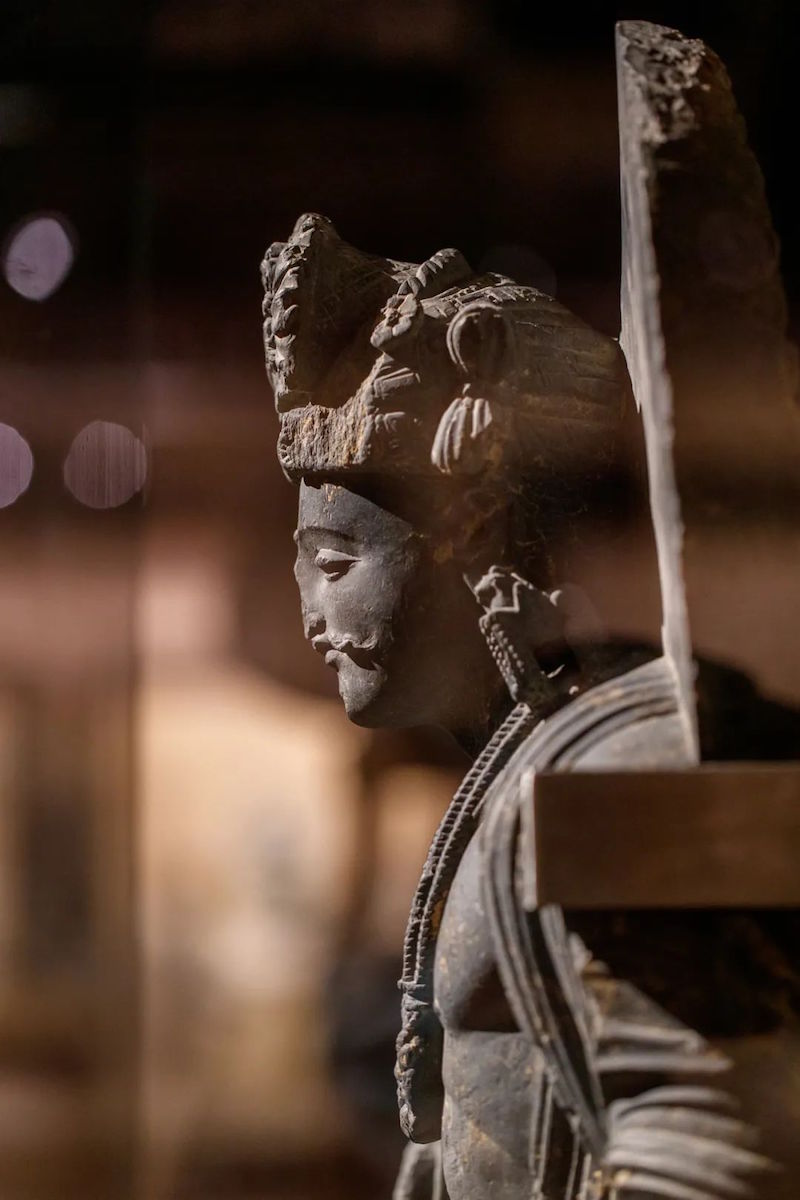
The exhibition hall of the Palace Museum "Like Fragrant Mountains: Gandhara Art Exhibition"
3. Charity and filial piety: Sacrificial feeding of tiger Jataka in the works of Fa Sheng
The Fasheng translation is rich in content and can provide a lot of details for understanding the Jataka who sacrificed himself to feed the tiger in Gandhara. The protagonist of the story is named Zhantan Moti, the only prince of Qiandamati Kingdom. At the beginning of the story, the story does not go straight to the theme to tell the plot of the prince giving up his life to feed the tiger, but first tells the plot of the prince giving alms at home and practicing as a monk, which is divided into three parts.
The first part talks about the various almsgiving activities of the prince when he was at home, including the alms giving of property and selling one's body, emphasizing the merits of almsgiving. The donation of property is "returning the garden to the palace, giving on the side of the road", "begging for alms storage, the king refuses", "giving money from the king", and "giving from the private collection of materials". The result of repeated donations is that the money has been exhausted, but there are still many poor people, which are not enough for a week. So the prince sneaked out of the palace city and went to Pei Tishe country, sold himself as a slave, and got money to continue giving. The prince went to the mountains as a slave to cut wages in the country of Petisha, and got the ox head sandalwood, which cured the king of leprosy. The king thanked him and promised to give half the country, but the prince did not accept it, and instead used his treasury to donate wantonly for fifty days.
Immediately afterwards, the reaction of the king, Mrs. Wang and the Crown Princess when they learned of the prince's departure is interspersed, highlighting the kindness of Mrs. Wang to the Prince:
At that time, Mrs. Wang was afraid of losing the prince, so she suddenly became crazy, and she was sent out of the city with the concubine and concubine, and ran from east to west in search of the prince. The king was afraid that his wife would be annoyed by thinking about his son, or it might be fatal... The lady said with tears: "If I lose my son now, what will I do with my life? I would rather die here than give it back.
Then turn back to the narration of the prince, which fully demonstrates the prince's filial piety to his parents. The prince resigned from the king and returned to the country after he felt the sorrow and distress of his parents and subjects because of their departure from the country. Worried about his parents' "sorry or death", he asked Wuniao to come first with the book; Mrs. Wang heard the letter and said, "It's like returning to the Soviet Union after death". After returning to the country, the prince apologized to the king on the grounds of "unfilial conduct of the son" and gave alms in the country for a year, which had a good effect of "the unjust enemies and evil people who hear the prince's merits and virtues will naturally cultivate goodness".
The second part talks about the prince's renunciation and his relationship with his parents after he became a monk. After the prince met Wutong Immortal on the mountain who "practices meditation and Taoism and seeks Bodhi", after various visualizations and thoughts, he resolutely gave up the accumulated merits of giving alms, and decided to stay in the mountain and learn Taoism from a teacher. What he pursues in practicing as a monk is "educating the world, so that everyone can practice goodness", which obviously surpasses the effect achieved by his dedication to charity.
After the prince became a monk, the king's envoy, Mrs. Wang and the princess went up the mountain to persuade him to return. Mrs. Wang even threatened her with her life, once again showing her love for the prince: "The husband planted grain to prevent hunger, dug a well to wait for thirst, set up a country to guard against thieves, and adopted a son to serve the elderly. If you don't return to the country now, my life will not be complete." However, the prince Strong willed, no intention of returning, "I would rather break my body here than return it." It was also revealed in many interviews that although the prince has become a monk, he still maintains close ties with his parents and family:
The prince replied: "... I am seeking to do nothing today, and I want to overcome the sufferings of all people. On the day of attaining the Tao, I will first save my parents. It is not far from here now, and I will go to worship at that time."
... Today, I am not far from my son, and I can comfort myself by paying for meals and exchanging news. So my wife got Wang's remonstrance, and she took a break from her worries. From time to time, people were sent to the mountains to provide food and various sweets and fruits, and all kinds of delicacies, to support the prince. The prince also came down from time to time, questioned his parents, and returned to the mountain to practice Taoism.
This shows the attitude and practice of the Gandhara region towards the relationship between monkhood and filial piety, and reflects the importance attached to filial piety in the Gandhara region.
The third part tells the story of the prince sacrificing his life to feed the tiger and his parents building a tower for it. First, it describes the scene that the prince and the immortals saw on the cliff:
At the foot of the mountain there are cliffs and deep valleys, and at the bottom there is a tiger mother who gave birth to seven new cubs. At that time, it was snowing heavily, and the tiger mother had been holding her cubs for many days, and she could not beg for food, fearing that the cubs would freeze to death, so she guarded the cubs from hunger. The snow continued to fall, and the mother and child died of hunger and poverty soon. The tiger mother was forced by hunger and wanted to eat her cubs. ...Going to the top of the cliff, looking down, I saw the tiger mother and her cubs covered in snow.
What the prince saw was a loving picture of a tiger mother giving up her life to protect her son. This can be echoed with Mrs. Wang's love for the prince repeatedly emphasized in the first two parts. The prince used his body to give to the hungry tiger in the animal way, just like a loving mother loving her son. He regarded the tiger mother who guarded and protected her son as his own child waiting to be fed, and achieved "great compassion and universal equality". This behavior surpassed my own teacher and five hundred classmates who were practicing together on the mountain. Finally, it tells about the prince's vow to throw himself into the cliff under the witness of everyone, everyone's reaction to the prince's sacrifice to feed a tiger, and the behavior of his parents to build a pagoda for him. Emphasized the retribution brought by this behavior "surpassing the nine kalpas before the master, and now attaining the Buddha's aid to the infinite".
Fasheng's translation uses various financial donations and stories of compassion and filial piety to pave the way for the prince's act of feeding a tiger, advancing layer by layer, highlighting the difficulty and greatness of this act, and naturally placing the act of feeding a tiger at a high level. The behavior of Prince Zhantan Moti from donating property to becoming a monk and then feeding tigers shows his gradual transcendence of past good deeds, practice methods, classmates and teachers, and declares the victory of the sacred over the secular and Buddhist outsiders. The concept of generosity, the spirit of compassion and filial piety, the thought of Mahayana Bodhisattva and the thought of achieving Dharmakaya are popular in Gandhara Buddhism.

The engraved stone of the Buddha's footprints is exhibited in "Bi Ruo Xiangshan: Gandhara Art Exhibition", the same below.
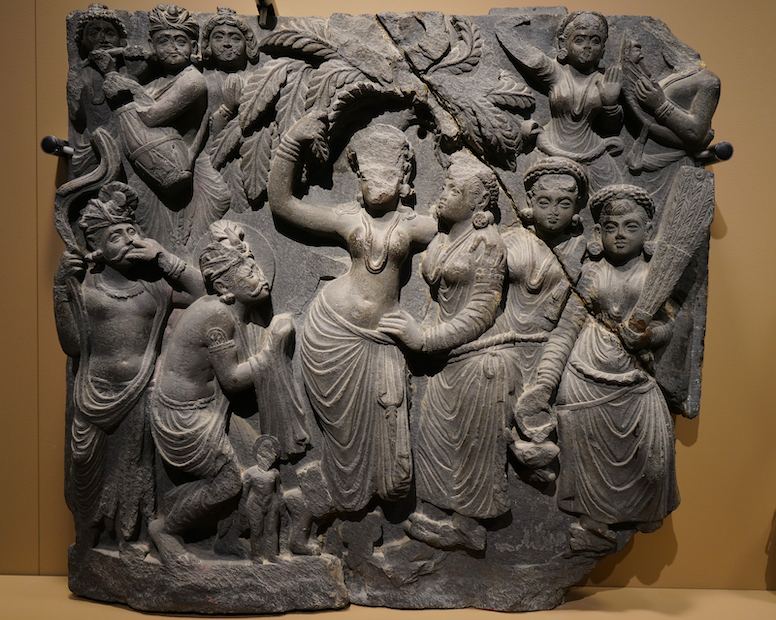
Prince Siddhartha is born
4. Surpassing Maitreya: Sacrifice to feed a tiger and the order of becoming a Buddha
The rise of the Kushan Empire greatly promoted the development of Buddhism, and Gandhara became the center of Buddhism in the world. In order to highlight Gandhara's central position in Buddhism, Kanishka I built the Cakri Stupa, which is known as "the most famous floating map in the Western Regions" in Fulusha, the capital of Guishan; a Buddhist holy object symbolizing Buddhism ——Buddha bowl (Pātra) was also robbed and enshrined here. Recreating holy sites through the stories of Buddha Jataka is also an important part of Gandhara's movement to shape its own Buddhist center. Many Jataka stories took place in Gandhara. For example, the famous Lantern Buddha's prophecy (also known as "Confucian boy Jataka"), this story endowed Sakyamuni with sanctity and legitimacy in becoming a Buddha in the future. The place where the tiger is sacrificed is also one of the Buddhist holy places that attracted Chinese monks to pray for the Dharma. It is an important Buddhist center in the Gandhara region.
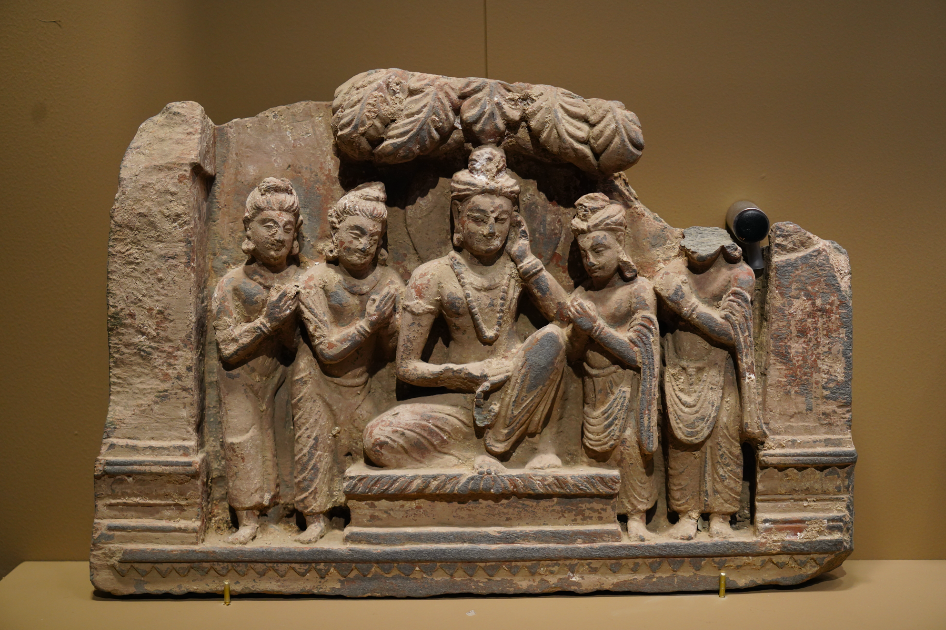
Thinking under the prince tree
Gandhara’s Sacrificial Tiger Jataka advocates compassion and filial piety, emphasizing the merits of giving, and worshiping the Sacrificial Tiger Pagoda also has the practical effect of curing diseases. This has won a wide base of believers for the story of sacrifice to feed the tiger, which is an important reason for the wide popularity of the story. But the reason why the place where the tiger was sacrificed to become a Buddhist holy place in Gandhara is not only because of these factors. At the end of Fasheng's translation, it reads:
Maitreya Bodhisattva has always been my teacher in the past, because I donate at the expense of my life to save sentient beings, I have surpassed the nine kalpas before my teacher, and now I have attained Buddhahood and saved the infinite.
This passage is the foothold of the whole scriptures, pointing out the core value of giving up one's life to feed a tiger. Because Sakyamuni sacrificed himself to feed a tiger in his previous life, he was able to surpass his teacher Maitreya Bodhisattva and become a Buddha first. This story plays a key role in the narrative logic of the sequence of Sakyamuni and Maitreya's enlightenment. Without this story, it would be impossible to explain why Sakyamuni was able to become a Buddha before Maitreya, and the order of the Buddhist world would fundamentally change.
In the order of the Buddhist world, Maitreya is the future Buddha who became a Buddha after Sakyamuni. But such an order was not predetermined from the outset. Why Sakyamuni was able to become a Buddha before Maitreya is an unavoidable question. In the second year of Tai'an (303), Zhu Fahu translated the "Maitreya Bodhisattva's Basic Vows Sutra", which reflects Maitreya's belief in rebirth, which is one of the earliest Chinese translations of Maitreya classics. The scriptures explain the order in which Sakyamuni and Maitreya became Buddhas:
Maitreya made the intention first forty-two kalpas before me, and then I sent out the Taoist intention. During this virtuous kalpa, I made great efforts to surpass the nine kalpas, and obtained the supreme and true way and became the most enlightened.
"On Differentiation of Merit and Virtue" also specifically explains this question in the form of questions and answers:
Among the Buddhas, those who are brave and diligent and have no faults in the Sakyamuni, Maitreya should be the first among the brothers, and now they are behind.
who? Thirty kalpas ago in the past, there were three bodhisattvas parading on the mountain together. From time to time, I saw a hungry tiger wanting to eat its son... that is, I threw myself down from the mountain to catch the tiger's mouth. The body is safe and hidden, and the tiger dare not eat. So you, those who have entered the samadhi of compassion, nothing can harm them. Therefore, it stabs itself with bamboo so that the tiger can eat. It is said to be brave, that is to say, it has surpassed nine kalpas, and it is now in front of Maitreya.
In this sutra, the only purpose of citing the story of the Jataka who sacrificed his life to feed the tiger is to explain the reason why Sakyamuni became a Buddha before Maitreya. Not only that, but through a comprehensive analysis of the early Chinese translations of the story of feeding a tiger, it can be found that this is also the most important and even the only purpose of citing the Jataka of giving up one’s life for more than two hundred years between the Han and Jin Dynasties. .
Among the existing Chinese translations, the earliest record of sacrificing oneself to feed tiger Jataka is "Cultivation Benqi Sutra", which is concise and concise: "For the sake of all living beings, I will devote myself to feeding hungry tigers, bravely and diligently, surpassing nine kalpas." This narrative appears in the burning lamp In the content of the Buddha's prophecy, the intention is very clear, and it is specially used to explain why Sakyamuni Buddha, who was supposed to become a Buddha in a hundred kalpas, became a Buddha in ninety-one kalpas. It can be seen that the main purpose of Sacrifice to feed the tiger Jataka was introduced to China at the beginning was to explain the specific time when Sakyamuni became a Buddha, and to emphasize the retribution of becoming a Buddha beyond the kalpa.
Kang Senghui's translation of "Six Paragraphs" (translated between 251 and 280) briefly described the plot of sacrificing his life to feed a tiger. At the end, he wrote: "Esz's fierce ambition, before the nine kalpas of all Bodhisattvas, vowed to take the five turbidities as the sky. Teachers, save all evils, and let the hypocrites follow the way." Zhi Qian's translation of "Wei Ri Miscellaneous Difficulties" does not quote the specific plot of giving up his body to feed a tiger, but directly points out the role of the story: "Bodhisattva holds his body to feed a hungry tiger, and he will not survive a hundred kalpas." Ninety-one kalpas will become a Buddha, and he will eliminate nine kalpas without feeling pain... He will starve a tiger with his body and become a Bodhisattva in the first nine kalpas." The relevant expressions in the Western Jin Faju translation of "Three Turns of the Past Life" are more clear: " '... At that time, the Brahman who threw himself into the hungry tiger was also my body; the person of the two ways was Kasyapa, Maitreya Bodhisattva.' The Buddha told Ananda: 'I am proficient in the Tao, and I have surpassed nine kalpas before Maitreya.' "
The study of the language of early Buddhist scriptures shows that the early Chinese translations may be the closest text to the original Gandhara Buddhist scriptures. Taking the "Practice of Practice" as an example, there is a very good correspondence between the early Chinese translation of the scriptures and the Buddhist images of Gandhara. The translators of these Buddhist scriptures, Zhu Dali, Kang Mengxiang, Kang Senghui, Zhiqian, etc., also had direct or indirect connections with the Gandhara region. Therefore, the interpretations of the fruit of sacrificing one’s life to feed a tiger Jataka in the above-mentioned scriptures not only represent the basic cognition of the Chinese Buddhist monks at that time, but also can reflect the gist that has been emphasized for a long time in Gandhara.
Jataka stories are an important part of Sakyamuni Buddha's life history. Similar to the prophecy given by the Burning Lamp Buddha, which gave Sakyamuni the legitimacy to be reincarnated and become a Buddha, Sakyamuni changed the specific time when Sakyamuni became a Buddha, and gave Sakyamuni the legitimacy to become a Buddha before Maitreya. The karma of over nine kalpas before Maitreya became a Buddha made the sacrificial tiger jakata a major event with a turning point in the sacred history of Sakyamuni, and it contributed to the sacrificial tiger jakata becoming one of the holy places and centers of Gandhara Buddhism root cause.
Note: This article is a phased achievement of the major project of the National Social Science Fund "Gandhara and Chinese Civilization Exchange History (Multiple Volumes)". "Junsheng", originally published in the 2022 winter volume of "Image History" edited by Liu Zhongyu, pp. 261-273. This article is published with permission of the author.

